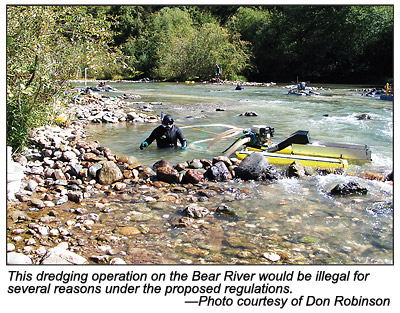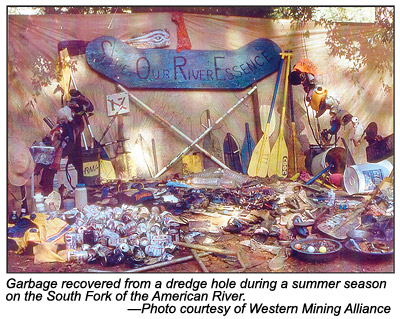Legislation & Regulation
Free / Legislation & Regulation
Revised Dredge Regulations Published for California—Pure Garbage
March 2012 by Scott
We can’t say it wasn’t expected. The California Department of Fish & Game released revised suction gold dredging regulations on February 17, 2012, and it’s obvious the agency wants to make life as difficult as possible for dredgers.
If you were dredging on a waterway of six feet or less before dredging was suspended in September 2009, the agency wants to permanently prevent you from operating in that location. Other waterways are closed or subject to shorter seasons and potential deposits are placed off limits if they are within three feet of a bank at the  current water level. There could easily be 4,000 dredgers contributing to the economy of California at current gold prices, but the agency wants to limit the number of permits to 1,500 without citing any scientific justification for the reduced number.
current water level. There could easily be 4,000 dredgers contributing to the economy of California at current gold prices, but the agency wants to limit the number of permits to 1,500 without citing any scientific justification for the reduced number.
The DFG is choosing to ignore the constructive comments from miners, former EPA scientists and others regarding the benefits of suction dredging and the mitigation it provides. The agency also wants to limit work hours to 10am - 4pm, which would be more restrictive than any other natural resource industry or business we are aware of. Even the San Jose (California) International Airport allows flights from 6:30am to 11:30pm over residential areas!
Key Points
• Maintain and submit an annual report card to include the location of each dredging site, dates and times of operation for each day, nozzle size, horsepower.
• Present license and report card when demanded by a DFG representative at any time.
• Permit suspension or revocation for failure to carry or present permit or report card upon demand for inspection.
• No suction dredge having an intake nozzle with an inside diameter larger than four inches may be used without an on-site inspection and written permission.
• Solid, one-piece, restrictor ring required and no quick release mechanism is allowed for the ring.
• The inside diameter of the intake hose may not be more than two inches larger than the permitted intake nozzle size.
• Intake pumps are required to be covered with a mesh screen with openings of 3/32” or less.
• A containment system must be added under motor and fuel tanks capable of handling the full contents of the fuel tank and lubricants.
• Motorized winching is only allowed after an on-site inspection.
• Winched materials must be left within the current water level.
• No operating within three feet of the lateral edge of the current water level, including the edge of instream gravel bars.
• No moving, cutting or destabilizing woody debris such as root wads, stumps or logs.
• Piling material to concentrate water flow can only be done after an on-site inspection and approval.
• No fuel, lubricants or chemicals may be stored within 100 feet of the current water level. If this is not feasible, a containment system must be in place beneath the containers and be capable of handling the full contents.
• Stream material may only be moved within the current water level.
• No displacing any material embedded on banks.
• No disturbing any mussel bed where at least 10 mussels are found within a square yard, and dredges and tailings must be at least 30 yards upstream or 10 yards laterally or downstream.
• Tailing piles shall be leveled before moving to another site or finishing for the season.
• Dredges must be cleaned of mud, oil, grease, debris, and plant and animal material before use.
• Dredges must be pressure washed with > 120-degree water or left to dry for two weeks before use in another location.
• No person shall operate a dredge within 500 feet of another dredge.
• Dredging is restricted to 10am to 4pm.
Arbitrary and Capricious
In addition to these arbitrary and capricious rules, countless rivers and streams have been placed off-limits while others are subject to shortened seasons, even where endangered or threatened species are not present.Also, the DFG released the revised regulations on February 17, 2012, and advised they would only accept comments until 5pm on March 5, 2012. It appears to be an obvious attempt to prevent those who are out
 working on their claims from having sufficient time to provide comments.
working on their claims from having sufficient time to provide comments.Comments Needed
We recommend that you immediately fire off an email or phone call to DFG to respectively request an extension of the comment period via email at dfgsuctiondredge@dfg.ca.gov or by phone at (530) 225-2275. Then, take the time to review the revised regulations and compose your comments. The revised regulations are available on our website at www.icmj.com or on the DFG website at www.dfg.ca.gov/suctiondredge/Copies of the revised regulations are also available for public review at the following DFG offices:
• 601 Locust Street, Redding
• 701 Nimbus Road, Suite A, Rancho Cordova
• 1807 13th Street, Suite 104, Office of Communications, Sacramento
• 7329 Silverado Trail, Napa
• 1234 E. Shaw Avenue, Fresno
• 3883 Ruffin Road, San Diego
• 4665 Lampson Avenue, Suite J, Los Alamitos
• 3602 Inland Empire Blvd., Suite C-220, Ontario
• 20 Lower Ragsdale Drive, Suite 100, Monterey
Comments can be mailed or hand-delivered to DFG at:
Suction Dredge Program
Revisions to Proposed Amendments
Department of Fish and Game
Northern Region
601 Locust Street
Redding, CA 96001
Written comments may also be submitted to DFG via email at: dfgsuctiondredge@dfg.ca.gov
Please include the following in the subject line for all comments submitted via email: Comments re Revisions to Proposed Amendments.

© ICMJ's Prospecting and Mining Journal, CMJ Inc.